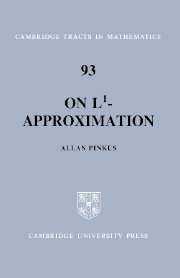Book contents
- Frontmatter
- Contents
- Preface
- 1 Preliminaries
- 2 Approximation from Finite-Dimensional Subspaces of L1
- 3 Approximation from Finite-Dimensional Subspaces in C1(K, μ)
- 4 Unicity Subspaces and Property A
- 5 One-Sided L1-Approximation
- 6 Discrete l1m-Approximation
- 7 Algorithms
- Appendix A T- and WT-Systems
- Appendix B Convexity Cones and L1-Approximation
- References
- Author Index
- Subject Index
- Frontmatter
- Contents
- Preface
- 1 Preliminaries
- 2 Approximation from Finite-Dimensional Subspaces of L1
- 3 Approximation from Finite-Dimensional Subspaces in C1(K, μ)
- 4 Unicity Subspaces and Property A
- 5 One-Sided L1-Approximation
- 6 Discrete l1m-Approximation
- 7 Algorithms
- Appendix A T- and WT-Systems
- Appendix B Convexity Cones and L1-Approximation
- References
- Author Index
- Subject Index
Summary
Any monograph should speak for itself, and this is no exception. However a few words of explanation would certainly do no harm. The linear theory of best uniform approximation is well documented both in journals and in books. The same cannot be said for the linear theory of best L1-approximation, which has generally received little attention.
This monograph (aside from a few digressions) is about the qualitative theory of best L1-approximation from finite-dimensional subspaces, where the approximation is either two-sided or one-sided. The questions considered are ‘classical’. What is, to me, surprising is that it is only in the last few years that many (but not all) of these questions have been answered. Thus most of the contents of Chapters 4 and 5, as well as some of the contents of Chapters 3 and 6, are the result of very recent research in this area.
This work is not all-encompassing. Various topics which could have been included are not. The most glaring of these omissions is the non-linear theory. I had originally intended to say something about this topic. But I found that I was being forced far a field in order to say relatively little. As of now, nonlinear L1-approximation theory is a poorly developed subject which deserves more attention.
Following each of the first six chapters is a series of exercises. These exercises are an integral part of this work and should be studied. They serve two main functions.
- Type
- Chapter
- Information
- On L1-Approximation , pp. ix - xPublisher: Cambridge University PressPrint publication year: 1989



